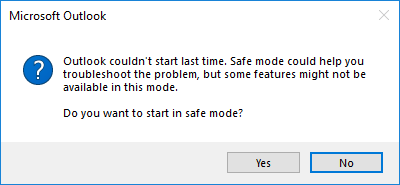

- #START OUTLOOK FOR MAC IN SAFE MODE HOW TO#
- #START OUTLOOK FOR MAC IN SAFE MODE SKIN#
- #START OUTLOOK FOR MAC IN SAFE MODE FULL#
- #START OUTLOOK FOR MAC IN SAFE MODE SOFTWARE#
/safe:1 – Launches Outlook in safe mode, without the reading pane.The following Outlook safe mode switches are compatible only with Microsoft Outlook versions 20: /safe – Launches Microsoft Outlook in safe mode, without add-ons and plug-ins – including Component Object Model add-ins – toolbar customization, or the reading pane.The only one compatible with all versions of Outlook is outlook.exe /safe. There are a number of “switches” you can add on to the outlook.exe /safe command to specify how safe mode should launch. Usually, the default installation folder for Microsoft Outlook is C:\Program Files\Microsoft Office\Office, with Office followed by your version number: for instance, Office12.Īre you using Microsoft Outlook 2010? Get started with this Outlook 2010 beginner’s course, or jump right into Outlook 2010 intermediate and Outlook 2010 advanced training courses.
#START OUTLOOK FOR MAC IN SAFE MODE FULL#
If for some reason your computer can’t find outlook.exe, you can ask it to navigate to the full location. If you don’t want to use Run or the command prompt, simply hold the Ctrl key and click the Outlook shortcut on your desktop, in the Start menu, or on your Quick Launch toolbar, and you will be prompted to launch Outlook in safe mode. Or, if you’re just interested in getting Outlook to work, check out this course on mastering Microsoft Outlook 2010, made easy!įor all of these operating systems, you can also type or find the Run prompt and type in outlook.exe /safe for the same results. Check out this computer essentials training course for a refresher. This will launch Microsoft Outlook in safe mode.įor Windows 8, press your Windows key, enter the Start screen, and type outlook.exe /safe before hitting Enter.Ĭonfused? Never fear. Next, just type in outlook.exe /safe and press Enter.
#START OUTLOOK FOR MAC IN SAFE MODE SKIN#
You can skip this step if you want, since Vista and 7 both have search bars in the Start menu, but in case you have a custom skin that removes this, then open the command prompt.
#START OUTLOOK FOR MAC IN SAFE MODE HOW TO#
How to Start Outlook in Safe Modeįor Windows Vista or Windows 7, go to Start, and type in cmd and Enter to open the command prompt.


#START OUTLOOK FOR MAC IN SAFE MODE SOFTWARE#
Learn more about the ins and outs of troubleshooting both software and hardware with this IT troubleshooting skills training course. If Outlook runs smoothly without its add-ons, it means the problem lies with one of these extra files, and not with the software or installation of the software itself, letting you rule those possibilities out. For more on troubleshooting, check out this guide on IT troubleshooting management.įor Microsoft Outlook, safe mode is a way to load the easily customizable application without any of its additional plug-ins or add-on files, in the case that one of these files is causing Outlook issues. It’s diagnostic, meaning it will not fix the issue your OS or program is facing, but will instead attempt to identify the root cause of the issue and offer a solution. Safe mode is an operational mode for running operating systems and certain types of software when they’ve encountered an error, or were forced to shut down unexpectedly. For more Microsoft Outlook general use tips, check out this introduction to Microsoft Outlook 2010 or this entry-level course for Outlook 2013. In this guide, we’ll review Outlook safe mode benefits, and explain how to enable it yourself. The first recommended method of troubleshooting Microsoft Outlook when it’s giving you problems is running the application in safe mode. It’s an extremely useful personal information manager for busy people and multi-taskers, but it’s not so useful if it isn’t working. With this tool, users can check their email, create and track tasks, take notes, keep a journal, and manage a personal calendar. Microsoft Outlook is an information management application that comes packaged with the Microsoft Office suite, or available as a stand-alone tool for people who only need Outlook specifically.


 0 kommentar(er)
0 kommentar(er)
